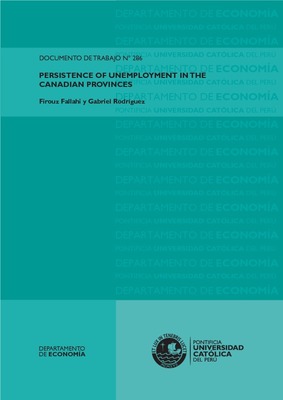| dc.contributor.author | Fallahi, Firouz | |
| dc.contributor.author | Rodríguez Briones, Gabriel H. | |
| dc.date.accessioned | 2015-03-19T20:37:49Z | |
| dc.date.available | 2015-03-19T20:37:49Z | |
| dc.date.issued | 2010 | |
| dc.identifier.uri | http://repositorio.pucp.edu.pe/index/handle/123456789/46927 | |
| dc.description.abstract | En este documento analizamos el grado de persistencia en las tasas de desempleo de las 10 provincias Canadienses utilizando datos trimestrales para el periodo 1976:1-2005:4. Como parte de la metodología, aplicamos un estadístico de raíz unitaria con dos quiebres calculado como el mínimo de los estadísticos LM estimados para cada observación. A diferencia de estadísticos de raíz unitaria tradicionales (con o sin quiebres), dicho estadístico permite encontrar estacionariedad en las diferentes tasas de desempleo dando respaldo a la teoría de la tasa natural de desempleo. Luego, usamos la metodología propuesta por Bai y Perron (1998,2003) para estimar un modelo lineal con múltiples cambios estructurales que permite estimar los diferentes grados de persistencia en los diferentes regímenes seleccionados. Los resultados sugieren que el grado de persistencia disminuye cuando múltiples quiebres estructurales son permitidos y modelados. Aspectos relacionados con la estructura del mercado laboral Canadiense, el sistema y programa de beneficios sociales, las transferencias inter-provinciales, y la movilidad inter-provincial son discutidos como explicaciones potenciales de los resultados obtenidos. | es_ES |
| dc.description.abstract | We analyze the degree of persistence of the unemployment rates of the 10 Canadian provinces using quarterly data for the period 1976:1-2005:4. We apply a two-break minimum Lagrange Multiplier unit root statistic, which, unlike standard unit root statistics (without or with breaks), makes it possible to find the stationarity of the different unemployment rates, giving support to the theory of the natural rate. We use the methodology of Bai and Perron (1998, 2003) to estimate a linear model with multiple structural changes to estimate the different degrees of persistence over the different regimes. The results suggest that the degree of persistence decreases when multiple breaks are allowed. Issues regarding the Canadian labor market, the insurance benefits program, inter-provincial transfers, and inter-provincial mobility are discussed as potential explanations for he results. | en_US |
| dc.language.iso | spa | es_ES |
| dc.publisher | Pontificia Universidad Católica del Perú. Departamento de Economía | es_ES |
| dc.relation.ispartof | urn:issn:2079-8466 | |
| dc.relation.ispartof | urn:issn:2079-8474 | |
| dc.relation.ispartofseries | Documento de Trabajo;286 | es_ES |
| dc.rights | info:eu-repo/semantics/openAccess | es_ES |
| dc.rights.uri | http://creativecommons.org/licenses/by-nc-nd/2.5/pe/ | * |
| dc.subject | Desempleo--Canadá | es_ES |
| dc.subject | Mercado de trabajo--Canadá | es_ES |
| dc.title | Persistence of unemployment in the Canadian provinces | es_ES |
| dc.title.alternative | Persistencia del desempleo en las provincias canadienses. | es_ES |
| dc.type | info:eu-repo/semantics/workingPaper | |
| dc.type.other | Documento de trabajo | |
| dc.subject.ocde | http://purl.org/pe-repo/ocde/ford#5.02.00 | |
| dc.publisher.country | PE | |
| renati.advisor.orcid | https://orcid.org/0000-0003-1174-9642 | |


